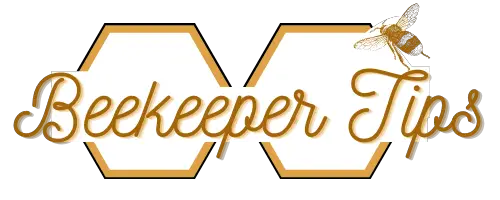In this article, we will take a look at bee feeder types. There is no best bee feeder – but there is a bee feeder which is best for you. Let us have a look at the options and how we can either buy or make a bee feeder.
Feeding liquid sugar to bees is an essential part of spring management to build your hives up. It is also an essential part of fall management to ensure your hives go into winter with enough stores. There are many other times when feeding can help. Knowing the various options available for feeding, the risks of the options, and how to deploy these options is important.
Table of Contents
Simple Top Feeder For Bees
You can make a really simple feeder for your bees as follows.
Place an inner cover on top of your hive.
Place two pencils or similar small spacers on either side of the ventilation hole in the cover. On top of these place one or two tubs that hold about a gallon each. I typically just pack this with a bit of straw and then fill it with sugar water. The straw stops the bees from drowning.
After you place the tubs you can place a deep super body and another lid on top. Typically we would set this up for feeding in the evening (this stops robbing problems). I normally perform two feeding cycles for my bees giving them a total of 4 gallons of sugar syrup. I have mild winters, you may need to do more than this.
Slightly Less Simple Top Feeder For Bees
If you want to be more complicated, you can make feeders that can be inverted and placed over the top bars of the hive. If you have a container, place a lid with holes on that container. Fill the container and invert it. The liquid will surprisingly not drain out. Instead, it will form a vacuum and stay in the container and the bees can sip the liquid out through the holes in the lid.
I really hate these feeders. The theory is sound – in practice, the bees often manage to disrupt the science of the system resulting in your bees being doused in sugar solution. Maybe I am just an idiot – but I have tried hundreds of different feeders on this inverted homemade configuration. All of them worked about 70% of the time, and 30% of the time dumped sugar on the bees causing chaos and mayhem in the apiary. Serious chaos and mayhem.
Feeders You Can Buy
If you do not wish to use the feeder tub I described above, you can always buy a pre-prepared unit such as this.
My general feeling would be that it seems to make a bit more sense just to repurpose some tubs than to buy round things that take up a lot of space in the hive. Square tubs provide a lot more volumetric efficiency than circular tubs. I see that some manufacturers have tried to solve this problem with square feeders that seem to be quite well put together.
Other Types Of Feeders You Can Use
Feeding bees with top feeders can trigger robbing. I have found that feeders that you can place in the hive can bypass this problem. In this regard, you can fashion your own feeders by just taking a frame and attaching sideboards on it, and then waterproofing this unit.
Alternatively, you can now buy frames type feeders that are specifically made to specification for feeding. I would suggest this.
These are very efficient feeders and you can encourage the bees to drink a lot of sugar water without too much fear of robbing. Generally, my advice would lean towards using these in any area where robbing by bees or yellow jackets and ants is a problem.
Hive Front Feeders
If you are in an area where the bees are not prone to robbing and you know the genetics of your bees you can use hive front feeders. Different races and genetic lines have a greater and lesser tendency to rob. You may also find that your bees don’t rob, but your neighbor’s bees do. There is nothing worse than feeding up someone else’s bees.
We must also remember yellow jackets. These horrible pests can gain entry into a hive and will be attracted by sugar water. In areas where this is a problem, hive top feeders are a bit better than hive front feeders.
Bespoke Feeders
There are some single-unit feeders that have now reached the market. These are a one-stop solution. These feeders are great and easy to use.
Boardman Type Feeders
In the times before things were too easily available, people used to fashion their own Boardman feeders. I used to make feeders that looked a bit like this. This is a perfectly functional feeder and uses a large mason-type jar as a sugar reservoir. Mine actually used to look a bit better than the ones you can now buy.
I found that they were a bit messy to set up and would always leak and seep a bit. They also attract ants to the front of the hive. But there are places in the world where these work. You may be in one of those.
Another Type Of DIY Feeder
I once had to feed up 100 hives and split them, and then feed those 100 hives and split them again. The timeline was very very tight. This involved feeding an inordinately huge amount of sugar on a weekly basis to the bees. We fashioned a simple feeder using paint tins.
If you take a gallon paint tin you can build an effective feeder. Purchase a synthetic gauze – I use a waterproofing membrane. Take the lid of the paint can and cut a big hole out of the middle. Fill the paint can with a sugar solution. Place the membrane over the mouth of the can and then hammer the lid with a hole in it onto the can.
When you invert this can, the bees can drink sugar from the membrane, and you get a very even slow feed. I normally invert three or four cans over the top bars of the hive. Then you place a deep super around the cans and a lid. This method is highly effective. You will find there are a small number of hives that will eat the membrane material.
I hope this article has helped you understand a few bee feeder types and how you can make your own feeders, or buy units which can solve some of the problems of feeding bees. If you enjoyed the article, please share.
Read more about:Â Making Sugar Water For Bees

Dr. Garth A. Cambray is a Canadian/South African entrepreneur and beekeeper with 28 years of experience in apiculture and specializes in adding value to honey. His Ph.D. research developed a new advanced continuous fermentation method for making mead that has resulted in a number of companies globally being able to access markets for mead. His company, Makana Meadery, exports honey mead to the USA where it is available to discerning connoisseurs. He has also developed technologies to commercially manufacture organic honey vinegar in Zambia for export globally. He holds a few patents globally in the ethanol industry and believes in technology and knowledge transfer for human development and environmental sustainability. One of his proudest achievements is the fact that the wind farm he started at one of his old apiary sites has essentially made his hometown carbon neutral.





